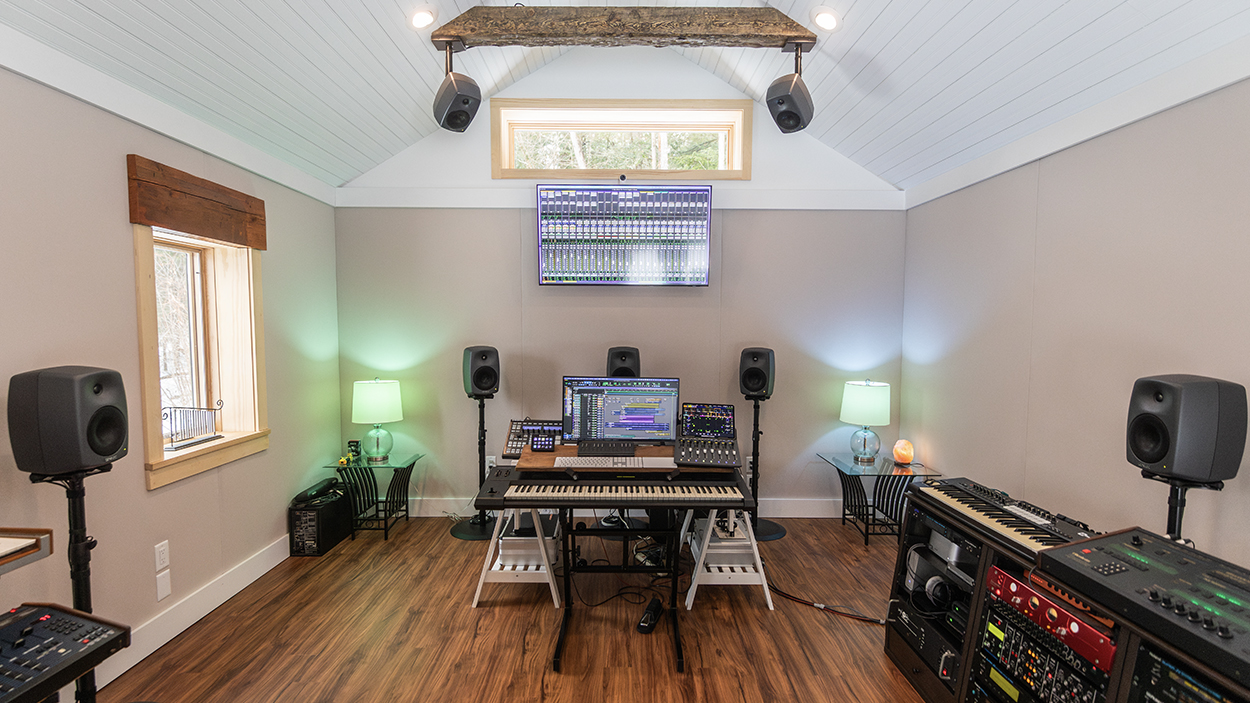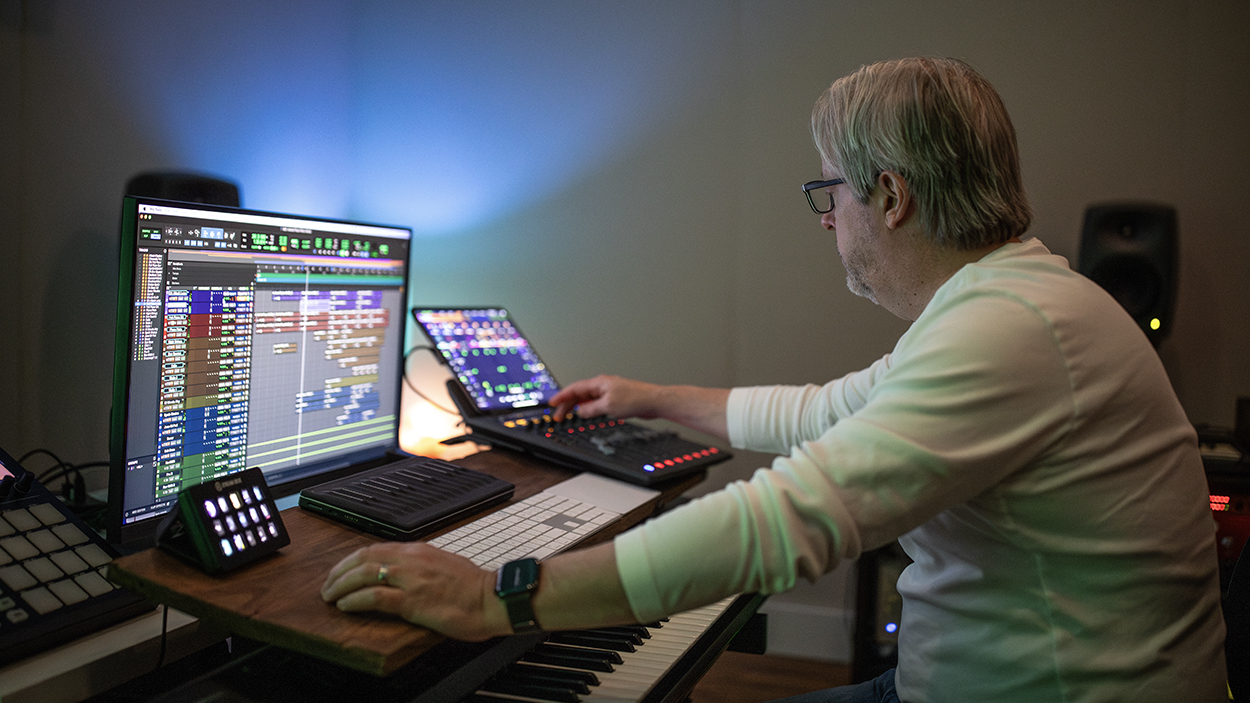Immersive Talk with Michael Crain
Can you please introduce yourself, tell us your job title, and tell us a little bit about what you do, and how you ended up doing it!
My name is Michael Crain, I’m a Composer/Producer/Programmer. Previously I worked in Chicago doing jingles and sessions, then moved to Orlando and worked with a lot of boy bands (Backstreet Boys, LFO, C-Note, Take 5), Jazz artists (The Rippingtons, Brian Culbertson, Eric Darius, Jeff Kashiwa, Paul Howards) as well as music for theme parks, attractions and TV/Film.
Now I’m Composing for installations and other projects and releasing Ambient/World/Contemporary Classical influenced music under Pangaea Projekt and Ambient with Jason Carey as Tiamatu.
Can you tell us about your studio space? Where its located, any history of the building, the approximate size of the studio?
My room was purpose built from my Father-In-Laws old shop on our property outside Burlington, Vermont. Sweeney Design Build, Jason Carey and I designed it and they built me an incredible studio. It’s based on a 20x16 foundation with a 14 foot cathedral ceiling. It’s really an idyllic space to create.

Can you give an overview of the key equipment you use in the studio – consoles/ DAW/processors/sound sources/signal distribution etc?
Pro Tools is where I create/edit/mix…. I’ve been using it for everything since Pro Tools 5. I have an Avid MTRX Studio that’s the hub of it all and an Avid S1 to control Pro Tools. The Mac Studio is the brains of the studio.
Then it’s a bunch of synthesizers both physical and virtual. I love, and still use on everything, my Oberheim Xpander. There are hardware pieces from Roland, Studio Electronics, Yamaha and E-mu. Software wise I love anything Spectrasonics comes out with, also Native Instruments, Arturia, Spitfire, Crow Hill and others. Since I started as a woodwind player, I have a Lyricon and Yamaha WX7 wind controllers. There’s a bunch of percussion instruments and flutes around the studio that I add to pieces too.
We designed a lot of the audio and ethernet routing in the walls to keep everything clean and out of the way. Village Voltage did the wiring and electrical work.
What type of work do you do in your studio?
I use the room for everything. From composing and programming, to mixing. For scoring to picture and albums (am I dating myself by saying that?) to Atmos work for installations and labels.
Is there a particular Immersive format you specialize in?
Atmos is the de facto standard and integrated so well in Pro Tools. With Apple Spatial Audio using that format as well. I’ve been releasing music solely on streaming platforms that support Atmos.

How and when did you become interested in immersive audio?
I’ve been interested in Immersive since I wrote music for the Orlando Science Center in their CineDome theater. It had 6 channel surround and it really helped me form my approach to immersive audio. 5.1 I thought would become a standard, and then when Gil Gowing and I mixed a piece of mine for Genelec at AES a few years ago it sold me as the way to go. Gil has been instrumental in my understanding of Atmos and a great source of
information.
What made you finally equip your studio for immersive, and can you describe how you did the upgrade? If you worked with any external people or had work done on the studio, can you provide some details?
This was a ground up “we’re making an Atmos studio”. I met with Sweeney Design Build and we had several discussions on what I wanted, how to go about doing it, the look of the studio & the vibe I wanted as well. I wanted windows so I could see nature when I’m working. I was also talking with Jason Carey about the particulars of what we wanted the studio to be and how best to do that. They brought the construction know how to my somewhat sky high expectations. The studio is a composing/programming/recording/mixing room. It had to have my instruments easily accessed and be able to mix in stereo and Atmos. Gil Gowing really helped with the routing setup.
Now that you are working in immersive, can you describe how you approach it, how it differs from stereo mixing, and what creative opportunities/challenges it presents?
The big thing for me was to, pardon the term, immerse people in the music. I love to use all the speakers in the room to place you squarely inside the music. That can mean orchestrating, doubling parts in the front and back and really utilizing the height speakers.
Can you describe your Genelec monitoring system (format, models etc)? Can you tell us why you chose Genelec, and how the monitoring system helps you to work in immersive?
I’ve been using my Genelec 1030’s for over 30 years and they still sound amazing. So there really wasn’t any thought of using another company. My Atmos setup is 7 8340’s, 4 8330’s and a 7370 sub. There was a bit of a learning curve getting used to the new speakers and room, but now I’m really comfortable with the space and the sound translates really well.
Did you use GLM (Genelec Loudspeaker Manager) to calibrate your system, and can you describe what difference that makes?
GLM made getting the system up and running a lot more precise and frankly easier
than I ever would have thought. Set up the mic and let it run and the EQ was set and
the speakers calibrated. Jason and I were really precise following the Dolby room
design tool and getting all the speakers placed and at the correct angles. It really sounds amazing. Paul at Genelec was a huge help as well.

Can you list some of the immersive projects you have worked on recently, and is your immersive room bringing you new business? Was it a good commercial decision?
I just released Pangaea Project “Winter Vol. X”, and am Composing for a couple of installations in Atmos, as well as a new Tiamatu release. I see Atmos as the future for music deliverables and I can’t wait to get to do more Atmos composing as well as mixing.
How do you see the future of immersive audio over the next few years?
I see it becoming the way people experience music. From video games to movies to albums even in their vehicles.




